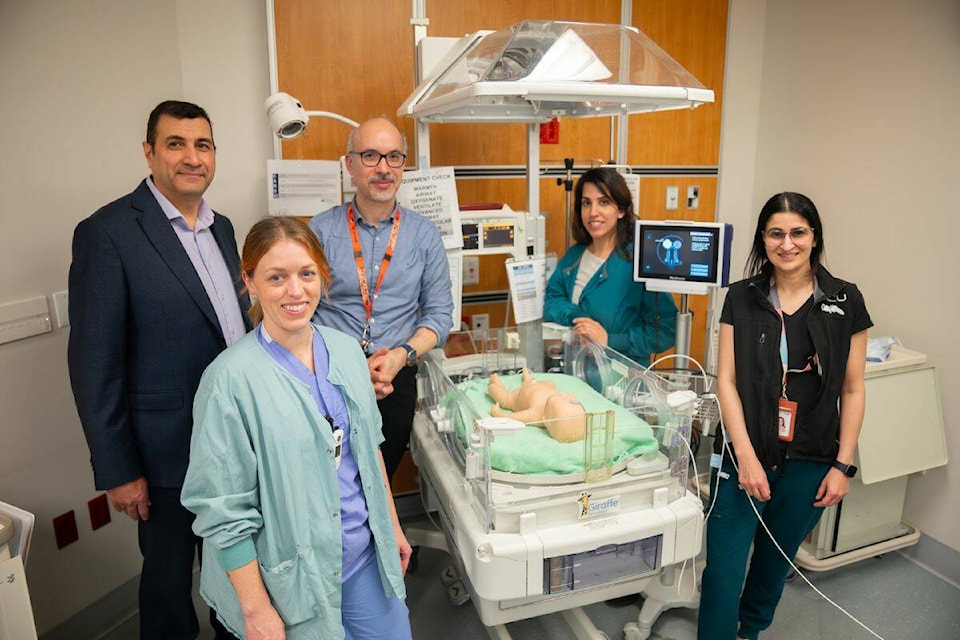Surrey Memorial Hospital’s neonatal intensive care unit (NICU) has received potentially life-saving technology that will help clinicians monitor in real-time how much oxygen a patient’s brain is consuming.
Dr. Samer Yousfi, a pediatrician and neonatologist at Surrey Memorial Hospital, told the Now-Leader he was excited when the four Near Infrared Spectroscopy (NIRS) monitoring devices were delivered last week.
“The brain is the most important organ, in my opinion, because it impacts your neurodevelopmental outcome, and it deserves to be the most important monitored during an ICU stay.” Before this technology it was often the least monitored organ because of “existing tradition technology,” Yousfi said.
“The innovative near-infrared spectroscopy monitoring devices will enable our pediatric clinicians to better monitor high-risk babies and will tremendously contribute to improved quality of care at our NICU,” he said.
Although the use of Near Infrared Spectroscopy technology in intenstive care units is not new, it is relatively new in NICUs.
“Surrey Memorial Hospital is among the first hospitals in British Columbia to use the NIRS monitoring devices to help pediatric clinicians conduct non-invasive and continuous real-time monitoring of tissue oxygenation saturation in cerebral tissue and other organs in high-risk babies in the NICU,” reads a Surrey Hospitals Foundation news release Friday (Feb. 29).
Normally, in an intensive care unit, clinicians will monitor a patient for a number of different things including, breathing, heart rate, blood pressure and more but they often do not monitor the brain continuously unless the patient tells them there is a problem, Yousfi said.
This tool will monitor and give continuous feedback about how much oxygen the patient’s brain is consuming. “If the brain is consuming too much oxygen, it matters, or if the brain is consuming very little oxygen, it also matters,” Yousfi said.
“It measures organ oxygen consumption and based on the consumption, you can say, ‘okay, the brain is taking enough oxygen, it’s happy, there is no concern.’” Or it can alert doctors and nurses that something is potentially wrong.
It is not a device that every patient in the 32-bed NICU will need, Yousfi said.
“On average, one out of eight neonates is in critical condition and at risk of developing a central nervous system injury,” Yousfi said. “I’m going to use this machine only for the patients who I think monitoring oxygen consumption matters,” Yousfi said.
The machine can be used to monitor oxygen levels in other organs, but in the NICU it will mainly be used to monitor oxygen levels in the brain.
There is an increased risk of long-term development outcomes for babies born prematurely, Yousfi said. If a baby is born with an issue in the lung or kidney, it can often be fixed or outgrown in the first few years of their life, he said.
“But if I have a problem in my brain, if I end up with a brain injury I have to live with the rest of my life.”
“Better monitoring for brain oxygenation and brain consumption can be used as another tool to better monitor neonates who may have this kind of brain injury and it can flag early enough certain abnormality, which we as the physician or nurses can act early, hopefully for the purpose of preventing injury or at least avoiding in significant danger.”
Ken and Ena McIntosh donated $60,000 to Surrey Hospitals Foundation to help purchase four Near Infrared Spectroscopy (NIRS) monitoring devices.
“In November 2023 our twin granddaughters were born prematurely at Surrey Memorial Hospital and spent three weeks at the NICU department and received such exceptional care from the NICU staff,” Ken McIntosh said in the foundation’s news release last week.
